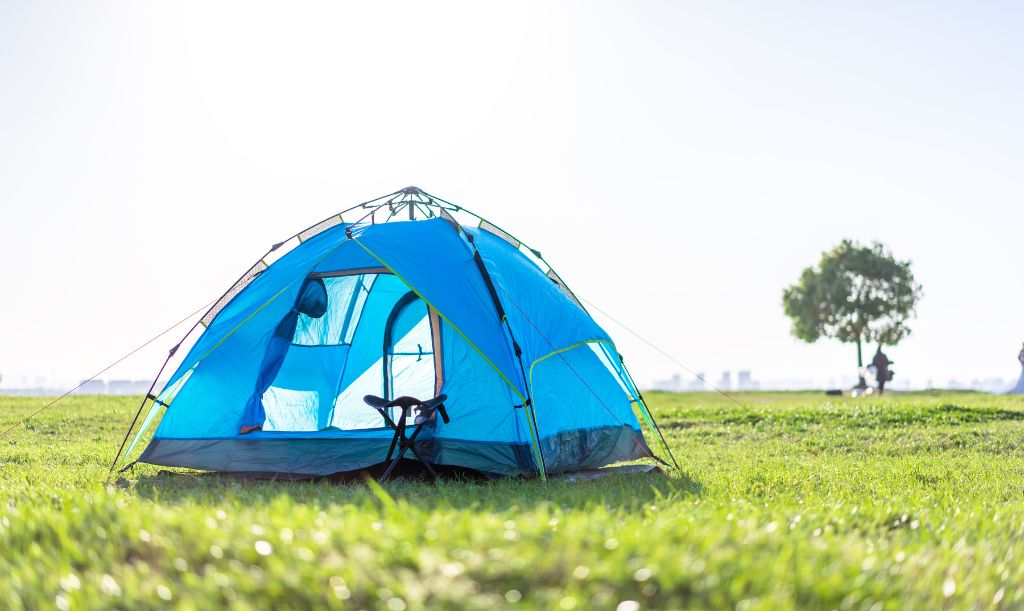Camping offers an escape from the daily grind, a chance to reconnect with nature and ignite a sense of adventure.
But before you embark on this journey, there’s a crucial piece of equipment that stands between you and that perfect outdoor experience: your tent.
It’s your home away from home, your shield against the elements, and the key to a comfortable night’s sleep under the vast expanse of the sky.
Choosing the right camping tent isn’t just about having a place to crawl in at night; it’s about setting the foundation for unforgettable memories.
This guide will be your compass, navigating you through all the essential factors to consider – from size and weight to weatherproofing and ease of setup.
Let’s begin!
Check the Price of a Camping Tent!
Essential Considerations for Choosing a Camping Tent

Just like snowflakes, no two camping trips are exactly alike.
The ideal tent for a solo backpacker summiting a peak will be vastly different from one needed for a family car camping getaway.
Here’s a breakdown of the key factors to consider to ensure your tent becomes a trusted companion on your outdoor adventures
Capacity
The first order of business is figuring out how many people (and perhaps even a furry friend!) will be sharing your tent. A cramped space can quickly turn a relaxing retreat into a frustrating experience.
- Solo Adventurers & Backpackers: Lightweight, one-person tents prioritize portability and offer enough space for a sleeping bag and minimal gear storage.
- Couples & Weekend Warriors: Two-person tents are the most popular choice, providing comfortable sleeping quarters and a touch of extra space for storing backpacks or duffel bags.
- Families & Groups: Three- and four-person tents offer more living space, ideal for families with children or groups of friends. Look for features like separate vestibules for storing gear and keeping dirty boots at bay.
Seasonality

Mother Nature can be unpredictable, so consider the type of weather you’ll be camping in most.
- Three-Season Tents: These tents are designed for fair-weather camping during spring, summer, and early fall. They offer good ventilation and protection from rain and wind showers.
- Four-Season Tents: Built for harsher conditions, four-season tents boast sturdier construction, enhanced weatherproofing, and features like additional poles for better snow load management. They’re ideal for winter camping or high-altitude adventures.
Weight and Portability

Weight becomes a critical factor for backpackers who prioritize efficiency on the trail. Every ounce counts, so backpacking tents are meticulously designed to be lightweight and pack down small.
- Backpacking Tents: Typically made with ultralight materials like silnylon or Dyneema Composite Fabric (DCF), backpacking tents can weigh as little as 2-3 pounds. This translates to a lighter pack and less strain on your body over long distances.
- Car Camping Tents: Car campers have more leeway when it comes to weight. These tents prioritize comfort and features over extreme portability, often offering more space, headroom, and amenities like built-in storage pockets. However, they tend to weigh upwards of 10 pounds.
Freestanding vs. Non-Freestanding Tents

Nobody wants to spend their precious vacation time wrestling with a complicated tent. Consider your comfort level and how much time you’re willing to dedicate to setup.
- Freestanding Tents: These tents pitch independently, meaning you can set them up virtually anywhere without needing stakes or guy lines to achieve proper tension. Freestanding tents are ideal for beginners or campers who frequently change locations.
- Non-Freestanding Tents: These tents require stakes and guy lines to maintain their structure. While they may take slightly longer to set up, non-freestanding tents can offer a lighter weight or more spacious design compared to their freestanding counterparts. They are a good option for experienced campers who prioritize specific features over a quick setup.
Weatherproofing
Your tent is your sanctuary, so ensuring it can withstand the elements is crucial. Here’s a breakdown of the key aspects of weatherproofing:
- Waterproofing: A good tent should have a waterproof rating, typically measured in millimeters (mm). A higher rating indicates better performance in heavy rain. Look for a tent with a rainfly made from a waterproof material like 210T polyester with a polyurethane (PU) coating of 1500mm or higher. The tent body itself should also be made from a water-resistant material with seam taping to prevent leaks at connection points.
- Wind Resistance: A strong wind can turn a cozy tent into a billowing sail. Look for a tent with a strong pole structure and a well-designed shape that sheds wind effectively. Features like guy lines and tension straps further enhance wind stability. Consider the wind potential at your camping destination and choose a tent that can handle the conditions.
Check the Price of a Waterproof Tent!
Livability

Beyond basic shelter, your tent should offer a comfortable living space that enhances your camping experience. Here are some factors to consider:
- Floor Space: Once you’ve factored in the number of occupants, think about how much space you’ll realistically need to move around comfortably. Having enough room to sit up, change clothes, and store gear contributes to a more enjoyable camping trip.
- Headroom: Don’t feel like you’re constantly ducking! Look for a tent with a good amount of headroom, especially if you’re tall or plan on spending extended periods of time inside the tent.
- Storage Space: Extra pockets, vestibules, and gear lofts can be lifesavers for keeping your tent organized and clutter-free. Having dedicated storage areas reduces the feeling of being cramped and ensures easy access to essential items.
Check the Price of a Large Tent!
Conclusion
By now, you’re equipped to navigate the world of camping tents with confidence!
Remember, the perfect tent hinges on understanding your camping style.
Whether you’re a solo adventurer scaling mountains or a family seeking a comfortable car camping retreat, considering factors like capacity, seasonality, weight, and ease of setup will ensure you find a tent that perfectly complements your needs.
Don’t forget to prioritize weatherproofing with features like a quality rainfly and a sturdy structure to handle wind.
Ventilation with strategically placed mesh panels is key to a comfortable night’s sleep, free from condensation.
Finally, focus on livability aspects like spacious floor area, ample headroom, and storage solutions to maximize your comfort and enjoyment.
With the right tent as your basecamp, you’re all set to transform your next camping trip into an unforgettable adventure.
- 7 Best Air Fryers 2025 (Ranked & Reviewed!) - December 30, 2024
- Best Cordless Blower (Latest Price & More…) - October 1, 2024
- Milwaukee Pruning Saw (Latest Price & More…) - October 1, 2024
